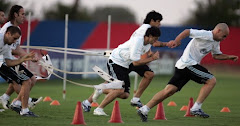Ok, so I have come to the conclusion once again (I have done this on many occasions) that I am the worst writer when it comes to organizing my thoughts and ideas on paper/computer. I have made every effort (well just time-several hours), to make sure that this damn thing makes sense. If it does not make sense and you have the urge to squirm and cringe while reading, please feel free to post a comment.
A lesson I would use to give students this authentic, real-world, ill-structured problem to solve would focus on a child’s Heart Rate (HR). After a short introduction to the functions and purpose of the heart, I would require every student to find their resting heat rate (RHR) and would demonstrate how to find an active heart rate (AHR).
Once a RHR has been calculated, I would ask the question, “What activities or games would require your HR to increase?” After hearing and writing at least ten activities (i.e. – kickball, basketball, tennis, interactive video games, etc.) I would ask the class, “Which of these activities that you have just mentioned would raise your heart rate the most and why?” Then I would ask them to place each in order of most likely to raise heart rate to least likely to raise heart rate. For example: 1-running (most likely), 5-basketball, and 10-kickball (least likely).
Once they have finished placing these activities in order, I would ask them to perform activity 1 (running), 5 (basketball), and 10 (kickball) and ask them to calculate the AHR for each student in their group at the conclusion of the activity. When they have finished each of the three activities and have joined their groups in the classroom they would share their results with other groups.
We would most likely find that some groups have a higher heart rate for basketball than running. Since this is not what these children had hypothesized prior to the activities, I would ask them to take the time and discuss this at home and post comments on a blog page.
I would hope that they understand or begin to realize that the differences in each group’s results could have been affected by the order in which a group performed their activities, the level of intensity, and/or the duration of the activity.
By using this lesson (which I hope has made some sense to the reader) one can see how it is consistent with constructivism. The lesson provides social negotiation and collaborative learning by using small groups in class followed by the entire class discussion on a blog page. It covers self-regulation and ownership in learning because each child is required to perform the activities and add ideas to their small groups.
Two areas of scaffolding that can be touched upon in this lesson are conceptual and metacognitive.
Conceptual, which focuses on what to consider when trying to solve the problems at hand, is discussed by understanding which order and to what duration and intensity the activities have performed may pla a role in the differences of the AHR.
Metacognitive scaffolding would provide guidance and how to think about the problem and how to understand and change their thinking about the problem when necessary. This would be obvious when groups come back with results that are different from their initial expectations, such as basketball having a higher ARH than running.
Once again, I hope this makes sense to the reader, I know it has to me, but I am the one writing this damn thing! HAHA Enjoy your day ; )
About Me
Blog Archive
Monday, November 5, 2007
Subscribe to:
Post Comments (Atom)
Categories
- metacognition and SR (1)
- Reflections (2)



3 comments:
Are are certainly not the worst writer... I feel the same way about organizing my thoughts. Especially when it's open to our peers and the public, YIKES! No worries, you're doing great!
Nice disclaimer... I would emphasize that the contructivist learning would take place while students come up with their own means of decided which activity would raise their heart rate the most.
Great idea for constructivist lesson, Dennis. Explained perfectly!
Post a Comment